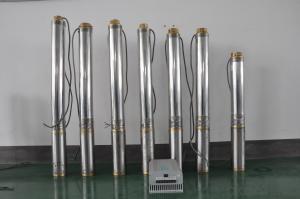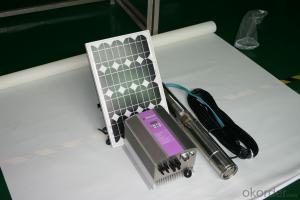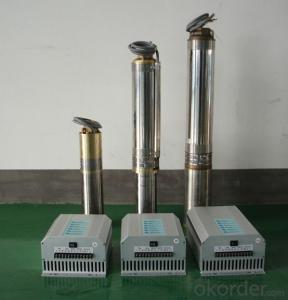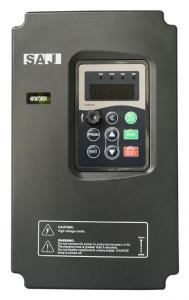Solar Pump
- Loading Port:
- China Main Port
- Payment Terms:
- TT OR LC
- Min Order Qty:
- -
- Supply Capability:
- -
OKorder Service Pledge
OKorder Financial Service
You Might Also Like
Item Description :
This superb new addition to our solar fountain range comes with a 10w solar panel,and a powerful fountain pump that is capable of producing fountains of up to 2m in height. As well as being easy to set up and use.Instruction manual is supplied for assembly and maintenance.
Solar Fountain Key Features :
Powered by direct sunlight
No high voltage electric mains required
Safe for children
Max. height of fountain: 2M
Max. flow capacity: 800 L/H(176 GAL)
10W Polycrystalline solar panel included
18V DC brushless pump
Solar Pump Features :
Can produce fountains up to : 2M (tube height) 1.4M (fountain height)
Comes with multiple nozzle accessories
Cable Length : 5M
Solar Panel Features :
10W peak power.
Polycrystalline highly efficient solar panel
Comes mounted in aluminium frame
Comes with ground stake and rotating knob so you can angle your panel toward the sun
What You Will Get :
10W solar panel
Solar pump
Ground Sake
Nozzle accessories
Precautions :
DO NOT alter or change the product itself or its components
Operate pump in freshwater only, never above 50 degrees celsius
Keep away from flammable liquids
Do not connect to any other power supply other than the included
- Q:How does the cost of operating a solar pump compare to an electric pump?
- Compared to an electric pump, the cost of operating a solar pump is generally lower. Solar pumps harness energy from the sun, which is a renewable and free power source. Once the solar panels and pump system are initially installed, ongoing operational costs are minimal since there are no fuel or electricity bills to pay. This makes solar pumps highly cost-effective in the long term. On the contrary, electric pumps rely on grid electricity, which usually comes at a cost. The operational expenses of electric pumps are determined by utility companies' electricity rates and can vary depending on the region. Additionally, electric pumps may require regular maintenance and repairs, which add to the overall operating cost. It should be noted that installing a solar pump may have a higher upfront cost compared to an electric pump, as it involves purchasing and installing solar panels, batteries, and a pump system. However, over time, the savings in operational costs of a solar pump can outweigh the initial investment. Moreover, solar pumps have an advantage in remote or off-grid locations where access to electricity may be limited or expensive. In such cases, the cost of extending power lines or using generators to operate electric pumps can be significantly higher compared to installing a solar pump system. In summary, although the initial investment in a solar pump may be higher, the cost of operating a solar pump is generally lower compared to an electric pump due to the absence of ongoing electricity bills and the utilization of renewable energy.
- Q:Can a solar pump be used in industrial cooling systems?
- Industrial cooling systems can indeed utilize solar pumps. These pumps find widespread application in irrigation, water supply, and heating/cooling systems. Their role in industrial cooling involves efficiently circulating water or heat transfer fluids, effectively eliminating heat from machinery or processes. Solar pumps bring multiple benefits, including reduced energy consumption, lower operating costs, and environmental sustainability. Nevertheless, determining the suitability of a solar pump for an industrial cooling system necessitates considering factors like cooling requirements, system design, available sunlight, and the specific needs of the industrial process. Moreover, it is crucial to assess the solar pump's capacity and performance to ensure it can adequately meet the cooling demands of the industrial application.
- Q:Can a solar pump be used in areas with limited access to financing options?
- Yes, a solar pump can be used in areas with limited access to financing options. Solar pumps are a cost-effective and sustainable alternative to traditional pumps that require electricity or fuel. Since solar pumps use the sun's energy to operate, they eliminate the need for ongoing operational costs. Additionally, there are various organizations and initiatives that provide support and funding for renewable energy projects, including solar pumps, in underserved areas. These options can help overcome financial barriers and make solar pumps accessible to communities with limited financing options.
- Q:Can a solar pump be used in areas with limited access to spare parts?
- Yes, a solar pump can be used in areas with limited access to spare parts. Solar pumps are designed to be durable and require minimal maintenance. They are built to withstand harsh environments and can operate for long periods without the need for spare parts. Additionally, solar pumps have fewer mechanical components compared to traditional pumps, reducing the chances of breakdowns and the need for spare parts. This makes them a reliable and cost-effective solution for areas with limited access to spare parts.
- Q:Can a solar pump be used in areas with limited access to electricity for backup systems?
- Yes, a solar pump can be used in areas with limited access to electricity for backup systems. Solar pumps utilize solar energy to operate and do not rely on grid electricity. They are an efficient and sustainable solution for areas where access to electricity is limited, providing a reliable backup system for water supply or irrigation needs.
- Q:How does a solar pump handle water source contamination from industrial waste?
- A solar pump alone does not directly handle water source contamination from industrial waste. However, it can be part of a larger water treatment system that helps address this issue. The contaminated water would first need to be treated and purified before it can be safely used by a solar pump. Various water treatment methods such as filtration, coagulation, disinfection, or reverse osmosis may be employed to remove or neutralize contaminants. Once the water is treated and deemed safe, a solar pump can then be used to extract and distribute the clean water from the source.
- Q:Can a solar pump be used for water supply in remote military bases?
- Yes, a solar pump can be used for water supply in remote military bases. Solar pumps are particularly well-suited for remote locations as they operate using solar energy, eliminating the need for a constant power supply or fuel. This makes them highly reliable and cost-effective for supplying water in areas where traditional power sources may not be readily available. Additionally, solar pumps can be easily installed and require minimal maintenance, making them a practical solution for remote military bases.
- Q:Are solar pumps suitable for use in agricultural greenhouses?
- Yes, solar pumps are suitable for use in agricultural greenhouses. Solar pumps provide a sustainable and cost-effective solution for irrigation and water circulation within greenhouses. They harness solar energy to power the pumps, reducing reliance on traditional energy sources and minimizing operating costs. Additionally, solar pumps can be easily installed and maintained, making them a practical choice for agricultural greenhouse operations.
- Q:Can solar pumps be used in saltwater or brackish water environments?
- Yes, solar pumps can be used in saltwater or brackish water environments. However, it is important to select appropriate materials and components that are resistant to corrosion caused by the salt content in the water.
- Q:How does the elevation of a location affect the performance of a solar pump?
- The elevation of a location can affect the performance of a solar pump in a few ways. Firstly, higher elevations typically have lower atmospheric pressure, which can reduce the efficiency of the pump's operation. This is because lower pressure results in a lower density of air, which in turn reduces the cooling effect on the solar panels, potentially causing them to overheat and decrease their efficiency. Additionally, at higher elevations, the intensity of sunlight may be higher due to less atmospheric filtering, which can offset some of the negative effects of lower pressure. However, it is important to note that the overall impact of elevation on a solar pump's performance may also depend on various other factors such as temperature, humidity, and local weather conditions.
1. Manufacturer Overview |
|
|---|---|
| Location | |
| Year Established | |
| Annual Output Value | |
| Main Markets | |
| Company Certifications | |
2. Manufacturer Certificates |
|
|---|---|
| a) Certification Name | |
| Range | |
| Reference | |
| Validity Period | |
3. Manufacturer Capability |
|
|---|---|
| a)Trade Capacity | |
| Nearest Port | |
| Export Percentage | |
| No.of Employees in Trade Department | |
| Language Spoken: | |
| b)Factory Information | |
| Factory Size: | |
| No. of Production Lines | |
| Contract Manufacturing | |
| Product Price Range | |
Send your message to us
Solar Pump
- Loading Port:
- China Main Port
- Payment Terms:
- TT OR LC
- Min Order Qty:
- -
- Supply Capability:
- -
OKorder Service Pledge
OKorder Financial Service
Similar products
New products
Hot products
Hot Searches
Related keywords




























